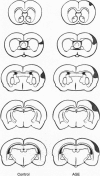Abstract
Cerebral infarction (stroke) is a potentially disastrous complication of diabetes mellitus, principally because the extent of cortical loss is greater in diabetic patients than in nondiabetic patients. The etiology of this enhanced neurotoxicity is poorly understood. We hypothesized that advanced glycation endproducts (AGEs), which have previously been implicated in the development of other diabetic complications, might contribute to neurotoxicity and brain damage during ischemic stroke. Using a rat model of focal cerebral ischemia, we show that systemically administered AGE-modified bovine serum albumin (AGE-BSA) significantly increased cerebral infarct size. The neurotoxic effects of AGE-BSA administration were dose- and time-related and associated with a paradoxical increase in cerebral blood flow. Aminoguanidine, an inhibitor of AGE cross-linking, attenuated infarct volume in AGE-treated animals. We conclude that AGEs may contribute to the increased severity of stroke associated with diabetes and other conditions characterized by AGE accumulation.
Full text
PDF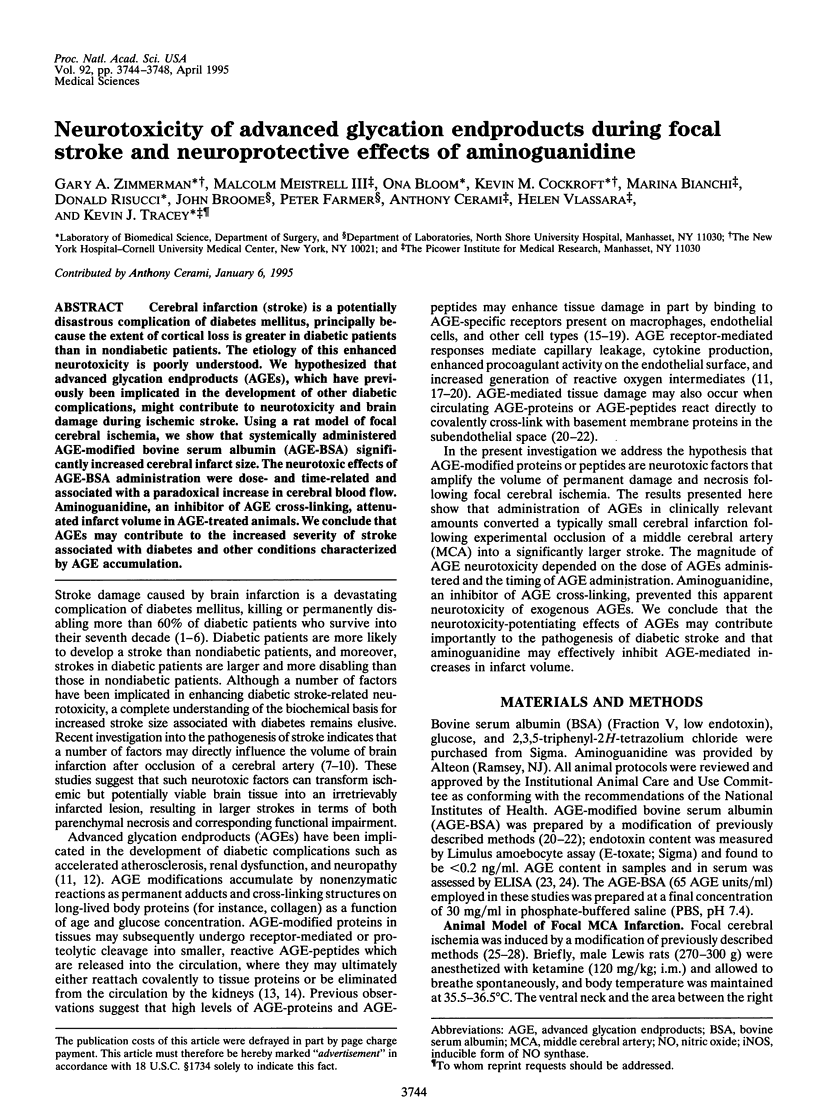
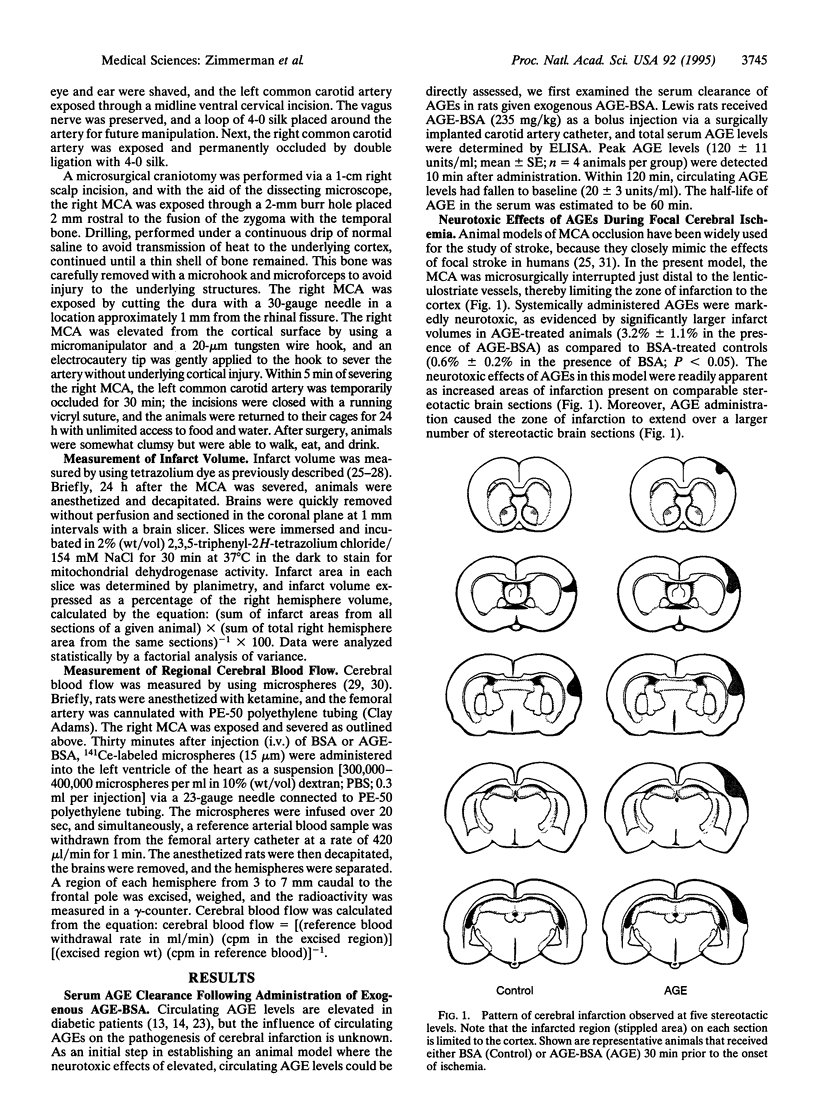
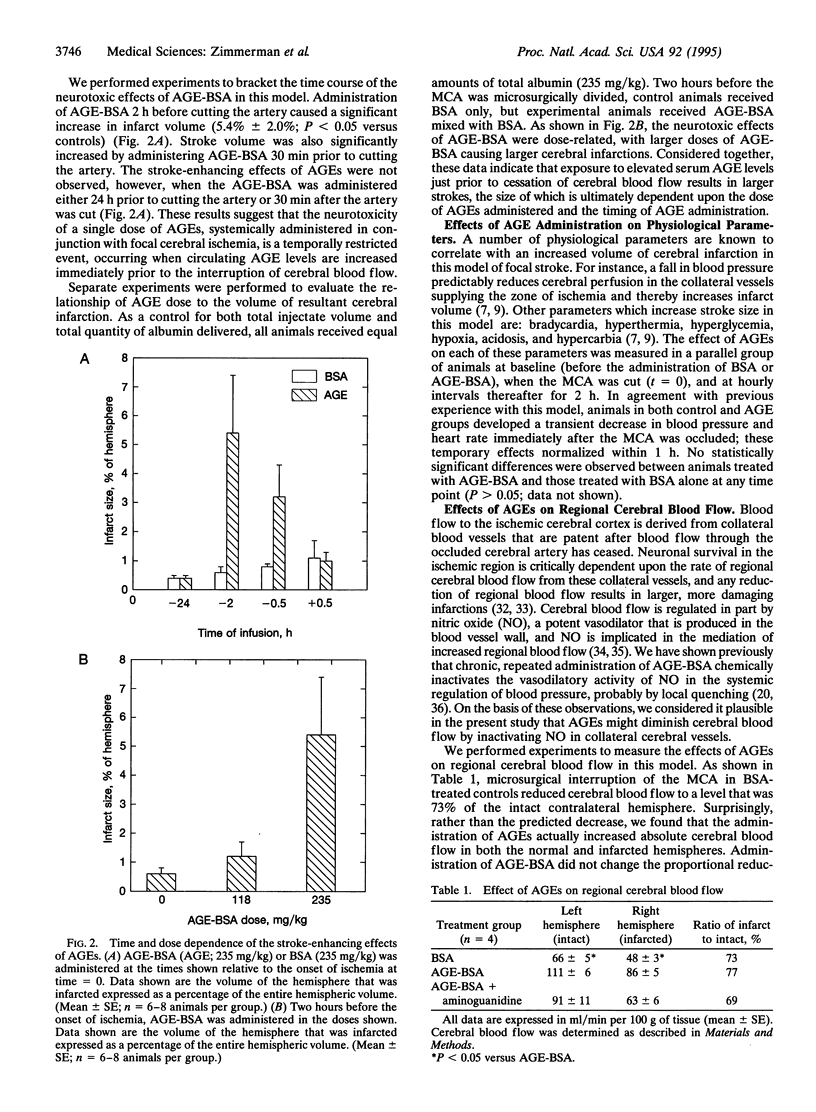
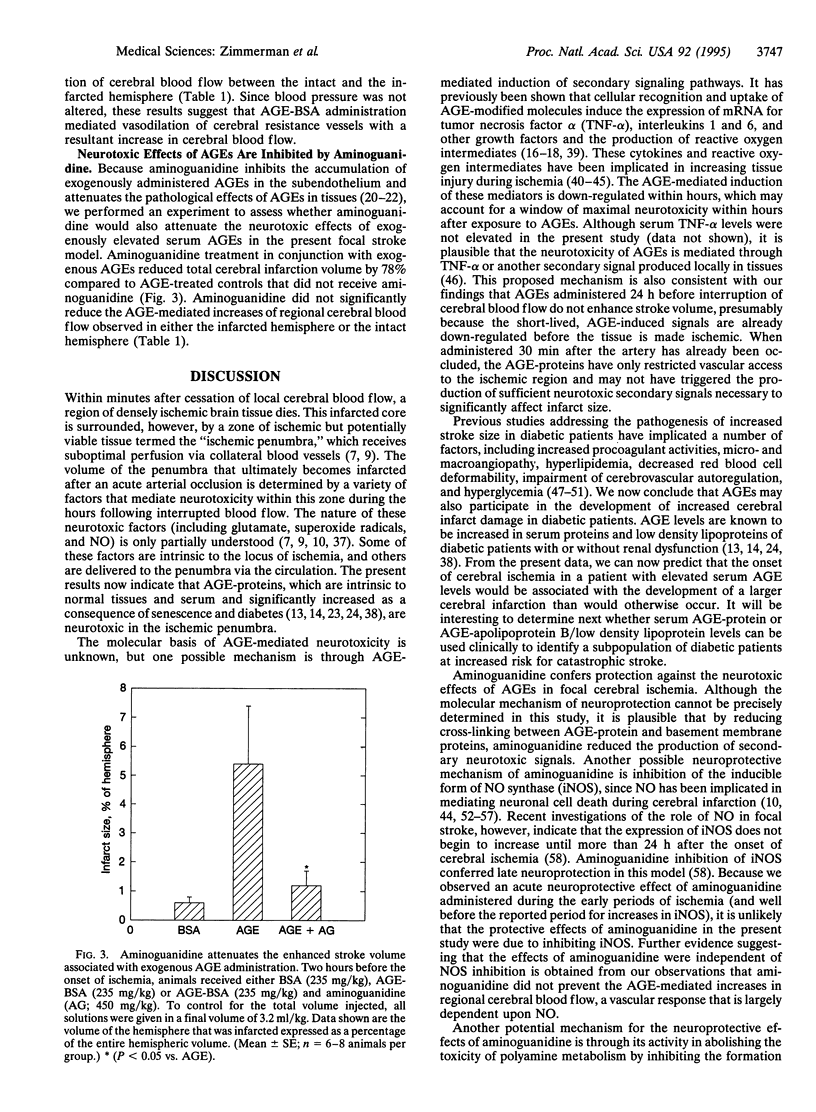
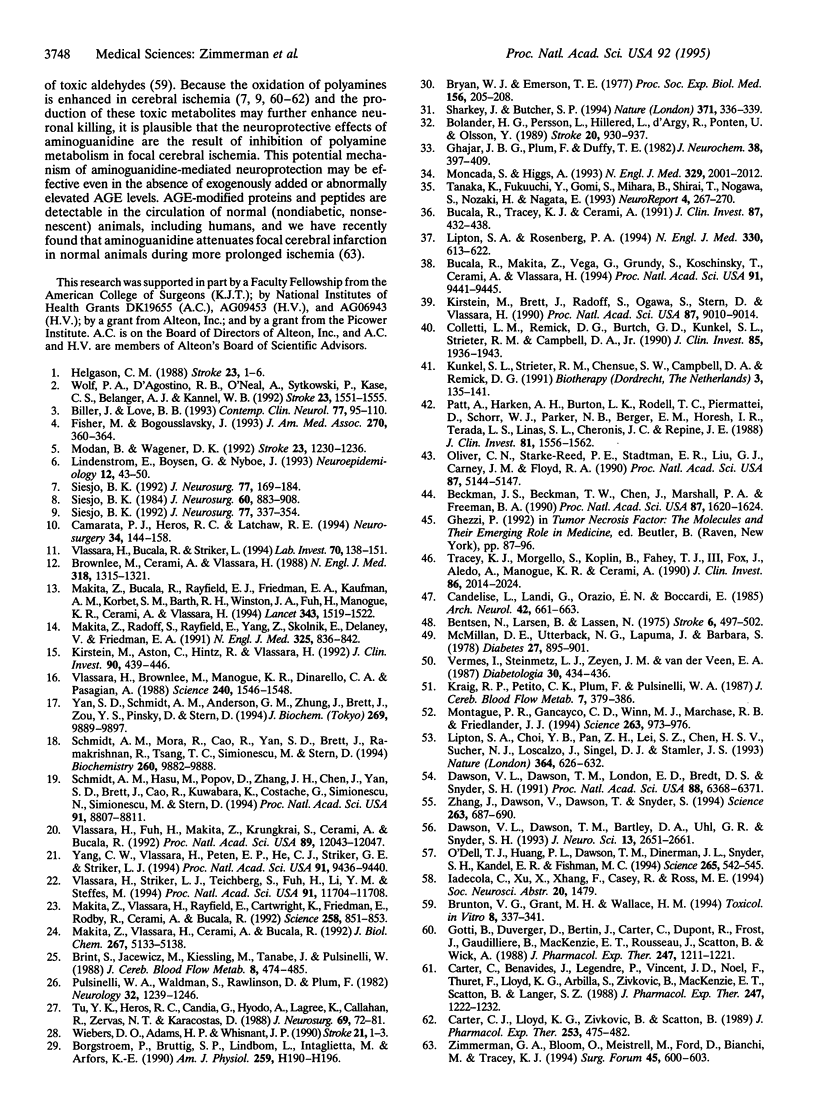
Images in this article
Selected References
These references are in PubMed. This may not be the complete list of references from this article.
- Beckman J. S., Beckman T. W., Chen J., Marshall P. A., Freeman B. A. Apparent hydroxyl radical production by peroxynitrite: implications for endothelial injury from nitric oxide and superoxide. Proc Natl Acad Sci U S A. 1990 Feb;87(4):1620–1624. doi: 10.1073/pnas.87.4.1620. [DOI] [PMC free article] [PubMed] [Google Scholar]
- Bentsen N., Larsen B., Lassen N. A. Chronically impaired autoregulation of cerebral blood flow in long-term diabetics. Stroke. 1975 Sep-Oct;6(5):497–502. doi: 10.1161/01.str.6.5.497. [DOI] [PubMed] [Google Scholar]
- Bolander H. G., Persson L., Hillered L., d'Argy R., Ponten U., Olsson Y. Regional cerebral blood flow and histopathologic changes after middle cerebral artery occlusion in rats. Stroke. 1989 Jul;20(7):930–937. doi: 10.1161/01.str.20.7.930. [DOI] [PubMed] [Google Scholar]
- Borgström P., Bruttig S. P., Lindbom L., Intaglietta M., Arfors K. E. Microvascular responses in rabbit skeletal muscle after fixed volume hemorrhage. Am J Physiol. 1990 Jul;259(1 Pt 2):H190–H196. doi: 10.1152/ajpheart.1990.259.1.H190. [DOI] [PubMed] [Google Scholar]
- Brint S., Jacewicz M., Kiessling M., Tanabe J., Pulsinelli W. Focal brain ischemia in the rat: methods for reproducible neocortical infarction using tandem occlusion of the distal middle cerebral and ipsilateral common carotid arteries. J Cereb Blood Flow Metab. 1988 Aug;8(4):474–485. doi: 10.1038/jcbfm.1988.88. [DOI] [PubMed] [Google Scholar]
- Brownlee M., Cerami A., Vlassara H. Advanced glycosylation end products in tissue and the biochemical basis of diabetic complications. N Engl J Med. 1988 May 19;318(20):1315–1321. doi: 10.1056/NEJM198805193182007. [DOI] [PubMed] [Google Scholar]
- Bryan W. J., Emerson T. E., Jr Blood flow in seven regions of the brain during endotoxin shock in the dog. Proc Soc Exp Biol Med. 1977 Nov;156(2):205–208. doi: 10.3181/00379727-156-39907. [DOI] [PubMed] [Google Scholar]
- Bucala R., Makita Z., Vega G., Grundy S., Koschinsky T., Cerami A., Vlassara H. Modification of low density lipoprotein by advanced glycation end products contributes to the dyslipidemia of diabetes and renal insufficiency. Proc Natl Acad Sci U S A. 1994 Sep 27;91(20):9441–9445. doi: 10.1073/pnas.91.20.9441. [DOI] [PMC free article] [PubMed] [Google Scholar]
- Bucala R., Tracey K. J., Cerami A. Advanced glycosylation products quench nitric oxide and mediate defective endothelium-dependent vasodilatation in experimental diabetes. J Clin Invest. 1991 Feb;87(2):432–438. doi: 10.1172/JCI115014. [DOI] [PMC free article] [PubMed] [Google Scholar]
- Camarata P. J., Heros R. C., Latchaw R. E. "Brain attack": the rationale for treating stroke as a medical emergency. Neurosurgery. 1994 Jan;34(1):144–158. doi: 10.1097/00006123-199401000-00021. [DOI] [PubMed] [Google Scholar]
- Candelise L., Landi G., Orazio E. N., Boccardi E. Prognostic significance of hyperglycemia in acute stroke. Arch Neurol. 1985 Jul;42(7):661–663. doi: 10.1001/archneur.1985.04060070051014. [DOI] [PubMed] [Google Scholar]
- Carter C. J., Lloyd K. G., Zivkovic B., Scatton B. Ifenprodil and SL 82.0715 as cerebral antiischemic agents. III. Evidence for antagonistic effects at the polyamine modulatory site within the N-methyl-D-aspartate receptor complex. J Pharmacol Exp Ther. 1990 May;253(2):475–482. [PubMed] [Google Scholar]
- Carter C., Benavides J., Legendre P., Vincent J. D., Noel F., Thuret F., Lloyd K. G., Arbilla S., Zivkovic B., MacKenzie E. T. Ifenprodil and SL 82.0715 as cerebral anti-ischemic agents. II. Evidence for N-methyl-D-aspartate receptor antagonist properties. J Pharmacol Exp Ther. 1988 Dec;247(3):1222–1232. [PubMed] [Google Scholar]
- Colletti L. M., Remick D. G., Burtch G. D., Kunkel S. L., Strieter R. M., Campbell D. A., Jr Role of tumor necrosis factor-alpha in the pathophysiologic alterations after hepatic ischemia/reperfusion injury in the rat. J Clin Invest. 1990 Jun;85(6):1936–1943. doi: 10.1172/JCI114656. [DOI] [PMC free article] [PubMed] [Google Scholar]
- Dawson V. L., Dawson T. M., Bartley D. A., Uhl G. R., Snyder S. H. Mechanisms of nitric oxide-mediated neurotoxicity in primary brain cultures. J Neurosci. 1993 Jun;13(6):2651–2661. doi: 10.1523/JNEUROSCI.13-06-02651.1993. [DOI] [PMC free article] [PubMed] [Google Scholar]
- Dawson V. L., Dawson T. M., London E. D., Bredt D. S., Snyder S. H. Nitric oxide mediates glutamate neurotoxicity in primary cortical cultures. Proc Natl Acad Sci U S A. 1991 Jul 15;88(14):6368–6371. doi: 10.1073/pnas.88.14.6368. [DOI] [PMC free article] [PubMed] [Google Scholar]
- Fisher M., Bogousslavsky J. Evolving toward effective therapy for acute ischemic stroke. JAMA. 1993 Jul 21;270(3):360–364. [PubMed] [Google Scholar]
- Ghajar J. B., Plum F., Duffy T. E. Cerebral oxidative metabolism and blood flow during acute hypoglycemia and recovery in unanesthetized rats. J Neurochem. 1982 Feb;38(2):397–409. doi: 10.1111/j.1471-4159.1982.tb08643.x. [DOI] [PubMed] [Google Scholar]
- Gotti B., Duverger D., Bertin J., Carter C., Dupont R., Frost J., Gaudilliere B., MacKenzie E. T., Rousseau J., Scatton B. Ifenprodil and SL 82.0715 as cerebral anti-ischemic agents. I. Evidence for efficacy in models of focal cerebral ischemia. J Pharmacol Exp Ther. 1988 Dec;247(3):1211–1221. [PubMed] [Google Scholar]
- Kirstein M., Aston C., Hintz R., Vlassara H. Receptor-specific induction of insulin-like growth factor I in human monocytes by advanced glycosylation end product-modified proteins. J Clin Invest. 1992 Aug;90(2):439–446. doi: 10.1172/JCI115879. [DOI] [PMC free article] [PubMed] [Google Scholar]
- Kirstein M., Brett J., Radoff S., Ogawa S., Stern D., Vlassara H. Advanced protein glycosylation induces transendothelial human monocyte chemotaxis and secretion of platelet-derived growth factor: role in vascular disease of diabetes and aging. Proc Natl Acad Sci U S A. 1990 Nov;87(22):9010–9014. doi: 10.1073/pnas.87.22.9010. [DOI] [PMC free article] [PubMed] [Google Scholar]
- Kraig R. P., Petito C. K., Plum F., Pulsinelli W. A. Hydrogen ions kill brain at concentrations reached in ischemia. J Cereb Blood Flow Metab. 1987 Aug;7(4):379–386. doi: 10.1038/jcbfm.1987.80. [DOI] [PMC free article] [PubMed] [Google Scholar]
- Kunkel S. L., Strieter R. M., Chensue S. W., Campbell D. A., Remick D. G. The role of TNF in diverse pathologic processes. Biotherapy. 1991;3(2):135–141. doi: 10.1007/BF02172086. [DOI] [PubMed] [Google Scholar]
- Lindenstrøm E., Boysen G., Nyboe J. Risk factors for stroke in Copenhagen, Denmark. II. Life-style factors. Neuroepidemiology. 1993;12(1):43–50. doi: 10.1159/000110298. [DOI] [PubMed] [Google Scholar]
- Lipton S. A., Choi Y. B., Pan Z. H., Lei S. Z., Chen H. S., Sucher N. J., Loscalzo J., Singel D. J., Stamler J. S. A redox-based mechanism for the neuroprotective and neurodestructive effects of nitric oxide and related nitroso-compounds. Nature. 1993 Aug 12;364(6438):626–632. doi: 10.1038/364626a0. [DOI] [PubMed] [Google Scholar]
- Lipton S. A., Rosenberg P. A. Excitatory amino acids as a final common pathway for neurologic disorders. N Engl J Med. 1994 Mar 3;330(9):613–622. doi: 10.1056/NEJM199403033300907. [DOI] [PubMed] [Google Scholar]
- Makita Z., Bucala R., Rayfield E. J., Friedman E. A., Kaufman A. M., Korbet S. M., Barth R. H., Winston J. A., Fuh H., Manogue K. R. Reactive glycosylation endproducts in diabetic uraemia and treatment of renal failure. Lancet. 1994 Jun 18;343(8912):1519–1522. doi: 10.1016/s0140-6736(94)92935-1. [DOI] [PubMed] [Google Scholar]
- Makita Z., Radoff S., Rayfield E. J., Yang Z., Skolnik E., Delaney V., Friedman E. A., Cerami A., Vlassara H. Advanced glycosylation end products in patients with diabetic nephropathy. N Engl J Med. 1991 Sep 19;325(12):836–842. doi: 10.1056/NEJM199109193251202. [DOI] [PubMed] [Google Scholar]
- Makita Z., Vlassara H., Cerami A., Bucala R. Immunochemical detection of advanced glycosylation end products in vivo. J Biol Chem. 1992 Mar 15;267(8):5133–5138. [PubMed] [Google Scholar]
- McMillan D. E., Utterback N. G., La Puma J. Reduced erythrocyte deformability in diabetes. Diabetes. 1978 Sep;27(9):895–901. doi: 10.2337/diab.27.9.895. [DOI] [PubMed] [Google Scholar]
- Modan B., Wagener D. K. Some epidemiological aspects of stroke: mortality/morbidity trends, age, sex, race, socioeconomic status. Stroke. 1992 Sep;23(9):1230–1236. doi: 10.1161/01.str.23.9.1230. [DOI] [PubMed] [Google Scholar]
- Moncada S., Higgs A. The L-arginine-nitric oxide pathway. N Engl J Med. 1993 Dec 30;329(27):2002–2012. doi: 10.1056/NEJM199312303292706. [DOI] [PubMed] [Google Scholar]
- Montague P. R., Gancayco C. D., Winn M. J., Marchase R. B., Friedlander M. J. Role of NO production in NMDA receptor-mediated neurotransmitter release in cerebral cortex. Science. 1994 Feb 18;263(5149):973–977. doi: 10.1126/science.7508638. [DOI] [PubMed] [Google Scholar]
- O'Dell T. J., Huang P. L., Dawson T. M., Dinerman J. L., Snyder S. H., Kandel E. R., Fishman M. C. Endothelial NOS and the blockade of LTP by NOS inhibitors in mice lacking neuronal NOS. Science. 1994 Jul 22;265(5171):542–546. doi: 10.1126/science.7518615. [DOI] [PubMed] [Google Scholar]
- Oliver C. N., Starke-Reed P. E., Stadtman E. R., Liu G. J., Carney J. M., Floyd R. A. Oxidative damage to brain proteins, loss of glutamine synthetase activity, and production of free radicals during ischemia/reperfusion-induced injury to gerbil brain. Proc Natl Acad Sci U S A. 1990 Jul;87(13):5144–5147. doi: 10.1073/pnas.87.13.5144. [DOI] [PMC free article] [PubMed] [Google Scholar]
- Patt A., Harken A. H., Burton L. K., Rodell T. C., Piermattei D., Schorr W. J., Parker N. B., Berger E. M., Horesh I. R., Terada L. S. Xanthine oxidase-derived hydrogen peroxide contributes to ischemia reperfusion-induced edema in gerbil brains. J Clin Invest. 1988 May;81(5):1556–1562. doi: 10.1172/JCI113488. [DOI] [PMC free article] [PubMed] [Google Scholar]
- Pulsinelli W. A., Waldman S., Rawlinson D., Plum F. Moderate hyperglycemia augments ischemic brain damage: a neuropathologic study in the rat. Neurology. 1982 Nov;32(11):1239–1246. doi: 10.1212/wnl.32.11.1239. [DOI] [PubMed] [Google Scholar]
- Schmidt A. M., Hasu M., Popov D., Zhang J. H., Chen J., Yan S. D., Brett J., Cao R., Kuwabara K., Costache G. Receptor for advanced glycation end products (AGEs) has a central role in vessel wall interactions and gene activation in response to circulating AGE proteins. Proc Natl Acad Sci U S A. 1994 Sep 13;91(19):8807–8811. doi: 10.1073/pnas.91.19.8807. [DOI] [PMC free article] [PubMed] [Google Scholar]
- Schmidt A. M., Mora R., Cao R., Yan S. D., Brett J., Ramakrishnan R., Tsang T. C., Simionescu M., Stern D. The endothelial cell binding site for advanced glycation end products consists of a complex: an integral membrane protein and a lactoferrin-like polypeptide. J Biol Chem. 1994 Apr 1;269(13):9882–9888. [PubMed] [Google Scholar]
- Sharkey J., Butcher S. P. Immunophilins mediate the neuroprotective effects of FK506 in focal cerebral ischaemia. Nature. 1994 Sep 22;371(6495):336–339. doi: 10.1038/371336a0. [DOI] [PubMed] [Google Scholar]
- Siesjö B. K. Cerebral circulation and metabolism. J Neurosurg. 1984 May;60(5):883–908. doi: 10.3171/jns.1984.60.5.0883. [DOI] [PubMed] [Google Scholar]
- Siesjö B. K. Pathophysiology and treatment of focal cerebral ischemia. Part I: Pathophysiology. J Neurosurg. 1992 Aug;77(2):169–184. doi: 10.3171/jns.1992.77.2.0169. [DOI] [PubMed] [Google Scholar]
- Siesjö B. K. Pathophysiology and treatment of focal cerebral ischemia. Part II: Mechanisms of damage and treatment. J Neurosurg. 1992 Sep;77(3):337–354. doi: 10.3171/jns.1992.77.3.0337. [DOI] [PubMed] [Google Scholar]
- Tanaka K., Fukuuchi Y., Gomi S., Mihara B., Shirai T., Nogawa S., Nozaki H., Nagata E. Inhibition of nitric oxide synthesis impairs autoregulation of local cerebral blood flow in the rat. Neuroreport. 1993 Mar;4(3):267–270. doi: 10.1097/00001756-199303000-00010. [DOI] [PubMed] [Google Scholar]
- Tracey K. J., Morgello S., Koplin B., Fahey T. J., 3rd, Fox J., Aledo A., Manogue K. R., Cerami A. Metabolic effects of cachectin/tumor necrosis factor are modified by site of production. Cachectin/tumor necrosis factor-secreting tumor in skeletal muscle induces chronic cachexia, while implantation in brain induces predominantly acute anorexia. J Clin Invest. 1990 Dec;86(6):2014–2024. doi: 10.1172/JCI114937. [DOI] [PMC free article] [PubMed] [Google Scholar]
- Tu Y. K., Heros R. C., Candia G., Hyodo A., Lagree K., Callahan R., Zervas N. T., Karacostas D. Isovolemic hemodilution in experimental focal cerebral ischemia. Part 1: Effects on hemodynamics, hemorheology, and intracranial pressure. J Neurosurg. 1988 Jul;69(1):72–81. doi: 10.3171/jns.1988.69.1.0072. [DOI] [PubMed] [Google Scholar]
- Vermes I., Steinmetz E. T., Zeyen L. J., van der Veen E. A. Rheological properties of white blood cells are changed in diabetic patients with microvascular complications. Diabetologia. 1987 Jun;30(6):434–436. doi: 10.1007/BF00292548. [DOI] [PubMed] [Google Scholar]
- Vlassara H., Brownlee M., Manogue K. R., Dinarello C. A., Pasagian A. Cachectin/TNF and IL-1 induced by glucose-modified proteins: role in normal tissue remodeling. Science. 1988 Jun 10;240(4858):1546–1548. doi: 10.1126/science.3259727. [DOI] [PubMed] [Google Scholar]
- Vlassara H., Bucala R., Striker L. Pathogenic effects of advanced glycosylation: biochemical, biologic, and clinical implications for diabetes and aging. Lab Invest. 1994 Feb;70(2):138–151. [PubMed] [Google Scholar]
- Vlassara H., Fuh H., Makita Z., Krungkrai S., Cerami A., Bucala R. Exogenous advanced glycosylation end products induce complex vascular dysfunction in normal animals: a model for diabetic and aging complications. Proc Natl Acad Sci U S A. 1992 Dec 15;89(24):12043–12047. doi: 10.1073/pnas.89.24.12043. [DOI] [PMC free article] [PubMed] [Google Scholar]
- Vlassara H., Striker L. J., Teichberg S., Fuh H., Li Y. M., Steffes M. Advanced glycation end products induce glomerular sclerosis and albuminuria in normal rats. Proc Natl Acad Sci U S A. 1994 Nov 22;91(24):11704–11708. doi: 10.1073/pnas.91.24.11704. [DOI] [PMC free article] [PubMed] [Google Scholar]
- Wiebers D. O., Adams H. P., Jr, Whisnant J. P. Animal models of stroke: are they relevant to human disease? Stroke. 1990 Jan;21(1):1–3. doi: 10.1161/01.str.21.1.1. [DOI] [PubMed] [Google Scholar]
- Wolf P. A., D'Agostino R. B., O'Neal M. A., Sytkowski P., Kase C. S., Belanger A. J., Kannel W. B. Secular trends in stroke incidence and mortality. The Framingham Study. Stroke. 1992 Nov;23(11):1551–1555. doi: 10.1161/01.str.23.11.1551. [DOI] [PubMed] [Google Scholar]
- Yan S. D., Schmidt A. M., Anderson G. M., Zhang J., Brett J., Zou Y. S., Pinsky D., Stern D. Enhanced cellular oxidant stress by the interaction of advanced glycation end products with their receptors/binding proteins. J Biol Chem. 1994 Apr 1;269(13):9889–9897. [PubMed] [Google Scholar]
- Yang C. W., Vlassara H., Peten E. P., He C. J., Striker G. E., Striker L. J. Advanced glycation end products up-regulate gene expression found in diabetic glomerular disease. Proc Natl Acad Sci U S A. 1994 Sep 27;91(20):9436–9440. doi: 10.1073/pnas.91.20.9436. [DOI] [PMC free article] [PubMed] [Google Scholar]
- Zhang J., Dawson V. L., Dawson T. M., Snyder S. H. Nitric oxide activation of poly(ADP-ribose) synthetase in neurotoxicity. Science. 1994 Feb 4;263(5147):687–689. doi: 10.1126/science.8080500. [DOI] [PubMed] [Google Scholar]



